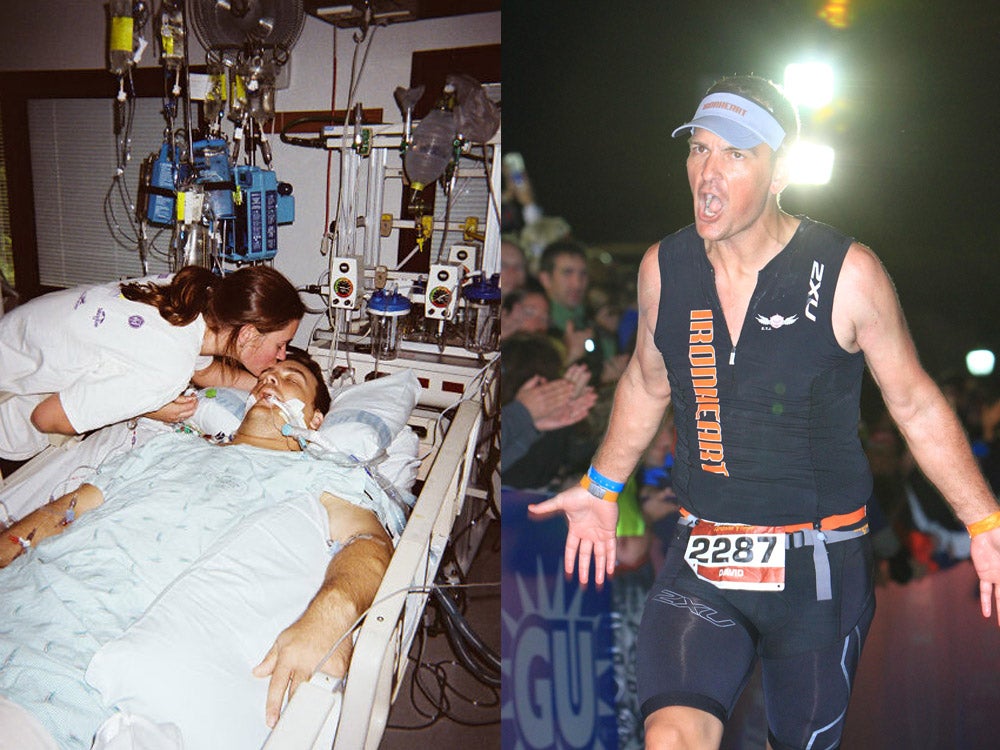Flatline To Finish Line: Triathlete Faces Heart Disorder, Becomes Ironman

David Watkins had just crossed the finish line of Seattle’s Seafair sprint triathlon in 2002 when everything went white. The 32-year-old former collegiate offensive lineman, marathoner and father of two young girls passed out cold. He wanted to believe it was a kudos-worthy sign that he’d pushed himself to the limit — that he’d given the race everything he had. After all, he was young, strong and fit. But deep down, he knew something was wrong.
After almost three years of tests and consultations, a cardiac surgeon at the University of Washington delivered horrifying news.
“He said my chances of going home, going to bed and waking up tomorrow were less than me going home, going to bed and never seeing tomorrow,” Watkins recalls.
Watkins was suffering complications of a bicuspid aortic valve, a congenital disorder in which the valve that regulates blood flow from the heart to the rest of the body, which is normally shaped like a three-pointed star, has only two points. He was developing an aneurysm, and he had a potentially deadly arrhythmia. On May 20, 2005, he underwent a 17-hour operation.
“The last thing I thought about as I was going into surgery was, ‘What’s my legacy? What footprints have I left my very young kids to follow in?’ I didn’t have an answer,” Watkins says.
When the procedure was over, his wife, Kerri, came to see him. Just as she looked through Watkins’ hospital room window, he flatlined. His surgeon rushed in, reopened Watkins’ chest, and massaged his heart by hand as Watkins was carted back into the operating room. Watkins’ heart didn’t have a beat for five minutes, yet he survived.
RELATED: Triathlon’s Danger Sign: Ventricular Tachycardia
Recovery wasn’t without hiccups. An order of kung pao shrimp sent Watkins into anaphylactic shock. Soon after, he suffered a mini stroke as he sat on his couch.
“When I recovered from that, I looked at Kerri and said, ‘I’m gonna do an Ironman,’” Watkins says. It would be his first crack at 140.6, a distance that spooks even the healthiest triathletes.
“Ironman didn’t scare me,” Watkins says. “What scared me was identifying myself as a sick person for the rest of my life.”
And so, 13 months after his lifesaving surgery, Watkins completed his first Ironman in Coeur d’Alene, Idaho. But when he missed the 17-hour cutoff, he had to reassess his goal. He started reaching out to other cardiac patient-athletes, and, in the process, realized how he would leave his mark on the world — by forming the Ironheart Foundation.
Part team, support system and referral network, Ironheart now has more than 400 members racing in 46 states and 14 countries to raise awareness of heart disease and money for research. The foundation also helps connect patients to healthcare providers who can assist with treatment and training.
In 2010, Watkins raced Ironman Florida in 15:05:04, and in 2012, he finished Ironman Arizona alongside seven cardiac patients he met while forming the foundation.
“Ironheart has given me the ability to give my children those life lessons,” Watkins says, of perseverance and doing what you love. “I think about needing surgery again every day. The big difference now is that I’ll roll in as a three-time Ironman triathlete that has been able to be there for my family, and to give others like myself a vehicle to live their own legacy.”
For more information on the Ironheart Foundation, and the foundation’s upcoming documentary, “Heart: Flatline to Finish Line,” go to Ironheartfoundation.org.
Follow Triathlete on Twitter @Triathletemag for inspiration, new workout ideas, gear reviews from our editors and more.